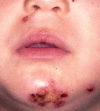Impetigo - review
- PMID: 24770507
- PMCID: PMC4008061
- DOI: 10.1590/abd1806-4841.20142283
Impetigo - review
Abstract
Impetigo is a common cutaneous infection that is especially prevalent in children. Historically, impetigo is caused by either group A β-hemolytic streptococci or Staphylococcus aureus. Currently, the most frequently isolated pathogen is S. aureus. This article discusses the microbiologic and virulence factors of group A β-hemolytic streptococci and Staphylococcus aureus, clinical characteristics, complications, as well as the approach to diagnosis and management of impetigo. Topical agents for impetigo therapy are reviewed.
Conflict of interest statement
Conflict of interest: None
Figures






Similar articles
-
Impetigo: an overview.Pediatr Dermatol. 1994 Dec;11(4):293-303. doi: 10.1111/j.1525-1470.1994.tb00092.x. Pediatr Dermatol. 1994. PMID: 7899177 Review.
-
Impetigo contagiosa III. Comparative efficacy of oral erythromycin and topical mupirocin.Pediatr Dermatol. 1989 Jun;6(2):134-8. doi: 10.1111/j.1525-1470.1989.tb01012.x. Pediatr Dermatol. 1989. PMID: 2501775 Clinical Trial.
-
Topical antibiotic treatment of impetigo with tetracycline.J Dermatol. 2005 Oct;32(10):788-92. doi: 10.1111/j.1346-8138.2005.tb00846.x. J Dermatol. 2005. PMID: 16361729 Clinical Trial.
-
Impetigo.Adv Emerg Nurs J. 2020 Oct/Dec;42(4):262-269. doi: 10.1097/TME.0000000000000320. Adv Emerg Nurs J. 2020. PMID: 33105179 Review.
-
NVC-422 topical gel for the treatment of impetigo.Int J Clin Exp Pathol. 2011 Aug 15;4(6):587-95. Epub 2011 Jul 23. Int J Clin Exp Pathol. 2011. PMID: 21904634 Free PMC article. Clinical Trial.
Cited by
-
Ideal Features of Topical Antibiotic Therapy for the Treatment of Impetigo: An Italian Expert Consensus Report.Curr Ther Res Clin Exp. 2022 Dec 24;98:100690. doi: 10.1016/j.curtheres.2022.100690. eCollection 2023. Curr Ther Res Clin Exp. 2022. PMID: 36712177 Free PMC article. Review.
-
Human microbiome: an academic update on human body site specific surveillance and its possible role.Arch Microbiol. 2020 Oct;202(8):2147-2167. doi: 10.1007/s00203-020-01931-x. Epub 2020 Jun 10. Arch Microbiol. 2020. PMID: 32524177 Free PMC article. Review.
-
Zosteriform impetigo: Wolf's isotopic response in a cutaneous immunocompromised district.Dermatol Pract Concept. 2015 Jul 31;5(3):35-9. doi: 10.5826/dpc.0503a09. eCollection 2015 Jul. Dermatol Pract Concept. 2015. PMID: 26336623 Free PMC article. Review.
-
Extensive Non-Bullous Facial Impetigo in an Adult.Vis J Emerg Med. 2023 Jul;32:101754. doi: 10.1016/j.visj.2023.101754. Epub 2023 Jun 22. Vis J Emerg Med. 2023. PMID: 37901479 Free PMC article. No abstract available.
-
Efficacy and tolerability of liposomal polyvinylpyrrolidone-iodine hydrogel for the localized treatment of chronic infective, inflammatory, dermatoses: an uncontrolled pilot study.Clin Cosmet Investig Dermatol. 2017 Sep 22;10:373-384. doi: 10.2147/CCID.S141887. eCollection 2017. Clin Cosmet Investig Dermatol. 2017. PMID: 28989281 Free PMC article.
References
-
- Oumeish I, Oumeish OY, Bataineh O. Acute bacterial skin infections in children. Clin Dermatol. 2000;18:667–678. - PubMed
-
- Vlassova N, Han A, Zenilman JM, James G, Lazarus GS. New horizons for cutaneous microbiology: the role of biofilms in dermatological disease. Br J Dermatol. 2011;165:751–759. - PubMed
-
- Chiller K, Selkin BA, Murakawa GJ. Skin microflora and bacterial infections of the skin. J Investig Dermatol Symp Proc. 2001;6:170–174. - PubMed
-
- Carrol JA. Common bacterial pyodermas. Postgrad Med. 1996;100:311-3, 317-22. - PubMed
-
- Luby SP, Agboatwalla M, Feikin DR, Painter J, Billhimer W, Altaf A, et al. Effect of handwashing on child health: a randomized controlled trial. Lancet. 2005;366:225–233. - PubMed
Publication types
MeSH terms
Substances
LinkOut - more resources
Full Text Sources
Other Literature Sources
Medical
